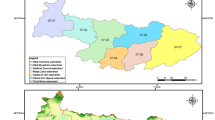Abstract
This study describes efforts to identify erosion-prone areas in the Gumara watershed using digital elevation model (DEM) data coupled with geographic information system (GIS). The software used to perform the overall analysis were the ESRI ArcGIS v10.3.1 with the ESRI Spatial Analyst and ArcHydro extension. All thematic layers (viz., slope, stream power index, drainage frequency, drainage density, drainage texture, relative relief, plan curvature, profile curvature) were integrated and analyzed in a GIS. A numeric evaluation scale from 1 to 4 was selected for ranking the subclasses of themes. The higher value, 4, represents higher impacts, while the lower value, 1, represents the lowest impact. About 21.71% of the total watershed area is under severe erosion zone. While 32.13%, 23.75%, and 22.42% of the total watershed area falls in moderate, low, and very low erosion zones respectively. In this paper, the numerical classification scheme presented constitutes an integrated approach that shows how to leverage basic watershed information to demarcate erosion prospective zones and measures at various scales for the purposes of watershed management.










Similar content being viewed by others
References
Cevik, E., & Topal, T. (2003). GIS-based landslide susceptibility mapping for a problematic segment of the natural pipeline, Hendek (Turkey). Environmental Geology, 44(8), 949–962.
Dornkamp, J. C., & King, M. (1971). Numerical analyses in geomorphology: an introduction. New York: St. Martins 372 p.
Gregory, K. J., & Walling, D. E. (1968). The variation of drainage density within a catchment. International Association of Scientific Hydrology - Bulletin, 13, 61–68.
Horton, R. E. (1945). Erosional development of streams and their drainage basins. Bulletin of the Geological Society of America, 56, 275–370.
Imran, A., Sankar, K., & Dar, M. A. (2012). Groundwater development in hardrock terrain using morphometric analysis. Environmental Geosciences, 19(4), 143–162.
Krishna Bahadur, K. C. (2009). Mapping soil erosion susceptibility using remote sensing and GIS: a case of the Upper Nam Wa Watershed, Nan Province, Thailand. Environmental Geology, 57, 695–705.
Moore, I. D., Grayson, R. B., & Ladson, A. R. (1991). Digital terrain modelling: a review of hydrological, geomorphological, and biological applications. Hydrological Processes, 5, 3–30.
Naik, M. G., Rao, E. P., & Eldho, T. I. (2009). Finite element method and GIS based distributed model for soil erosion and sediment yield in a watershed. Water Resources Management, 23(3), 553–579.
Pachauri, A. K., & Pant, M. (1992). Landslide hazard mapping based on geological attributes. Engineering Geology, 32(1, 2), 81–100.
Schumm, S. A. (1956). Evolution of drainage systems and slopes in badlands at Perth Amboy, New Jersey. Bulletin of the Geological Society of America, 67, 597–646.
Smith, K. G. (1950). Standards for grading texture of erosional topography. American Journal of Science, 248, 655–688.
Strahler, A. N. (1964). Quantitative geomorphology of drainage basins and channel networks. In V. T. Chow (Ed.), Handbook of Applied Hydrology (pp 439–476). New York: McGraw-Hill.
Tian, Y. C., Zhou, Y. M., Wu, B. F., & Zhou, W. F. (2009). Risk assessment of water soil erosion in upper basin of Miyun Reservoir, Beijing, China. Environmental Geology, 57(4), 937–942.
Wisler, C. O., & Brater, B. F. (1959). Hydrology. New York: Wiley.
Withanage, N. S., Dayawansa, N. D. K., & De Silva, R. P. (2014). Morphometric analysis of the Gal Oya river basin using spatial data derived from GIS. Tropical Agricultural Research, 26(1), 175–188.
Author information
Authors and Affiliations
Corresponding author
Rights and permissions
About this article
Cite this article
Ahmad, I. Digital elevation model (DEM) coupled with geographic information system (GIS): an approach towards erosion modeling of Gumara watershed, Ethiopia. Environ Monit Assess 190, 568 (2018). https://doi.org/10.1007/s10661-018-6888-8
Received:
Accepted:
Published:
DOI: https://doi.org/10.1007/s10661-018-6888-8




